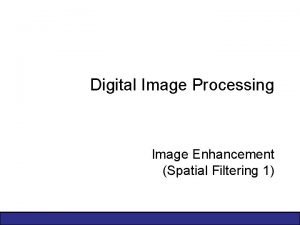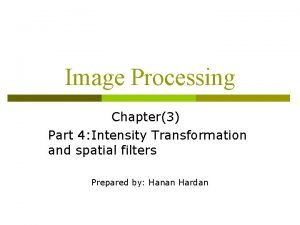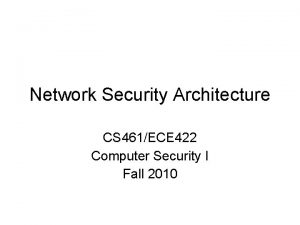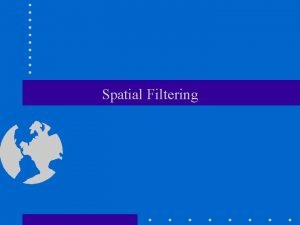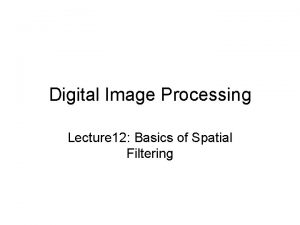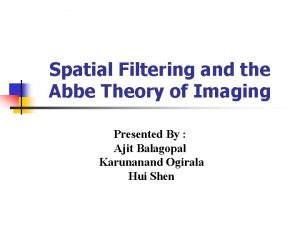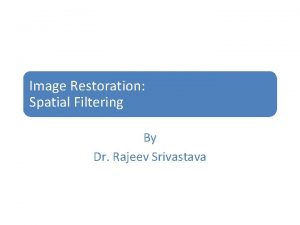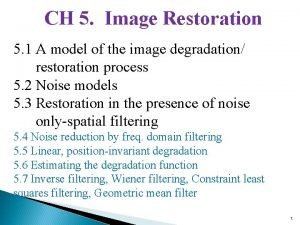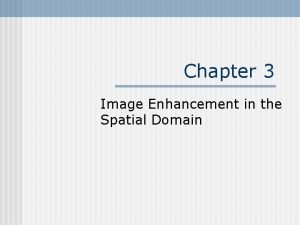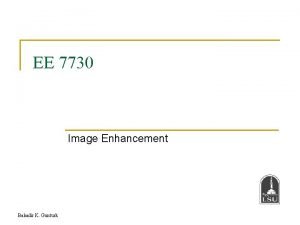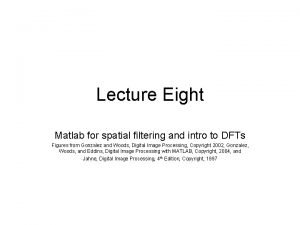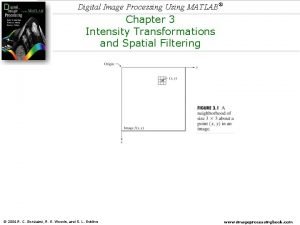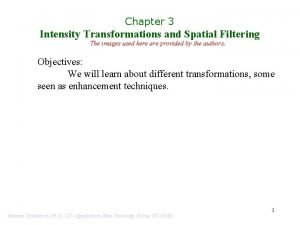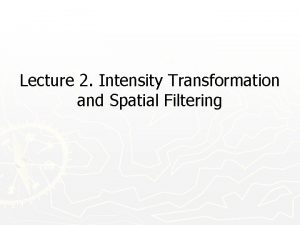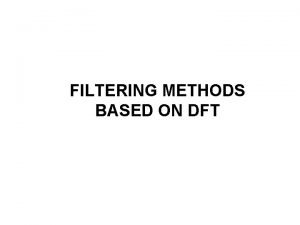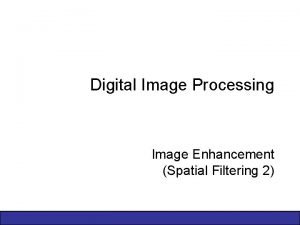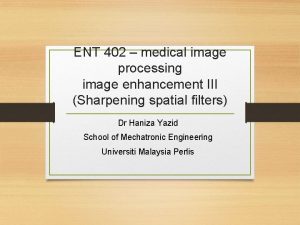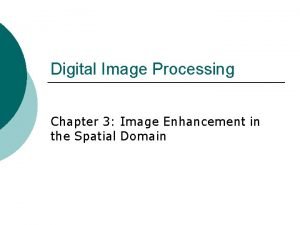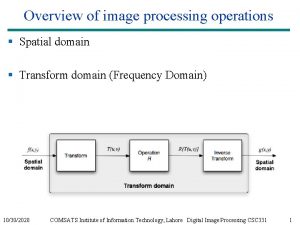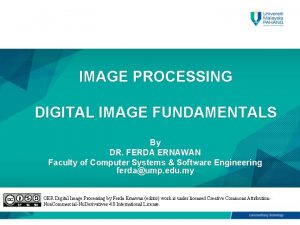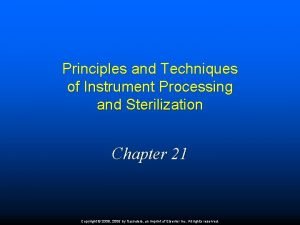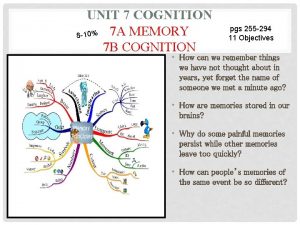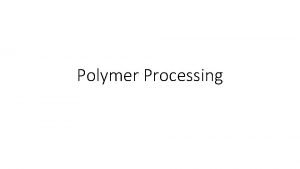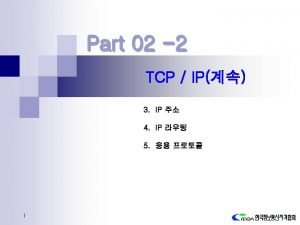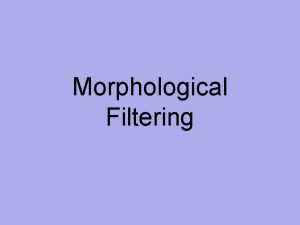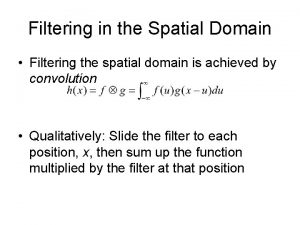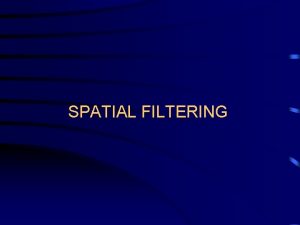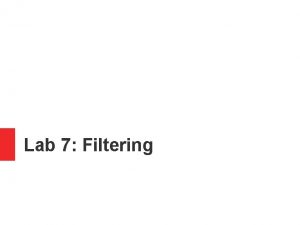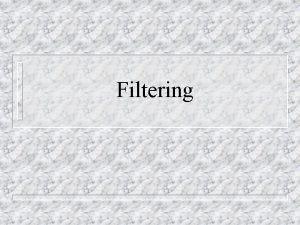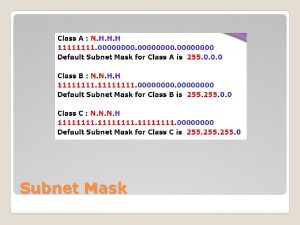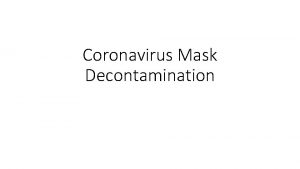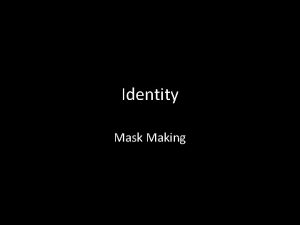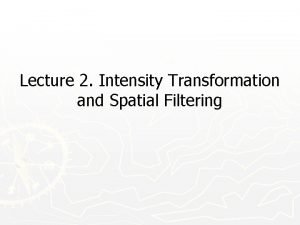Spatial Filtering Spatial Filtering Methods or Mask Processing













































- Slides: 45

Spatial Filtering

Spatial Filtering Methods (or Mask Processing Methods) output image

Spatial Filtering • The word “filtering” has been borrowed from the frequency domain. • Filters are classified as: – – Low-pass (i. e. , preserve low frequencies) High-pass (i. e. , preserve high frequencies) Band-pass (i. e. , preserve frequencies within a band) Band-reject (i. e. , reject frequencies within a band)

Spatial Filtering (cont’d) • Spatial filtering is defined by: (1) A neighborhood (2) An operation that is performed on the pixels inside the neighborhood output image

Spatial Filtering - Neighborhood • Typically, the neighborhood is rectangular and its size is much smaller than that of f(x, y) - e. g. , 3 x 3 or 5 x 5

Spatial filtering - Operation Assume the origin of the mask is the center of the mask. for a 3 x 3 mask: for a K x K mask:

Spatial filtering - Operation output image • A filtered image is generated as the center of the mask moves to every pixel in the input image.

Handling Pixels Close to Boundaries pad with zeroes 0 0 0 ………………………. 0 or

Linear vs Non-Linear Spatial Filtering Methods • A filtering method is linear when the output is a weighted sum of the input pixels. • Methods that do not satisfy the above property are called nonlinear. – e. g. ,

Linear Spatial Filtering Methods • Two main linear spatial filtering methods: – Correlation – Convolution

Correlation w(i, j) g(i, j) Output Image f(i, j)

Correlation (cont’d) Often used in applications where we need to measure the similarity between images or parts of images (e. g. , pattern matching).

Convolution • Similar to correlation except that the mask is first flipped both horizontally and vertically. Note: if w(x, y) is symmetric, that is w(x, y)=w(-x, -y), then convolution is equivalent to correlation!

Example Correlation: Convolution:

How do we choose the elements of a mask? • Typically, by sampling certain functions. Gaussian 1 st derivative of Gaussian 2 nd derivative of Gaussian

Filters • Smoothing (i. e. , low-pass filters) – Reduce noise and eliminate small details. – The elements of the mask must be positive. – Sum of mask elements is 1 (after normalization) Gaussian

Filters (cont’d) • Sharpening (i. e. , high-pass filters) – Highlight fine detail or enhance detail that has been blurred. – The elements of the mask contain both positive and negative weights. – Sum of the mask weights is 0 (after normalization) 1 st derivative of Gaussian 2 nd derivative of Gaussian

Smoothing Filters: Averaging (Low-pass filtering)

Smoothing Filters: Averaging (cont’d) • Mask size determines the degree of smoothing and loss of detail. original 3 x 3 15 x 15 5 x 5 25 x 25 7 x 7

Smoothing Filters: Averaging (cont’d) Example: extract, largest, brightest objects 15 x 15 averaging image thresholding

Smoothing filters: Gaussian • The weights are samples of the Gaussian function σ = 1. 4 mask size is a function of σ :

Smoothing filters: Gaussian (cont’d) • σ controls the amount of smoothing • As σ increases, more samples must be obtained to represent the Gaussian function accurately. σ=3

Smoothing filters: Gaussian (cont’d)

Averaging vs Gaussian Smoothing Averaging Gaussian

Smoothing Filters: Median Filtering (non-linear) • Very effective for removing “salt and pepper” noise (i. e. , random occurrences of black and white pixels). averaging median filtering

Smoothing Filters: Median Filtering (cont’d) • Replace each pixel by the median in a neighborhood around the pixel.

Sharpening Filters (High Pass filtering) • Useful for emphasizing transitions in image intensity (e. g. , edges).

Sharpening Filters (cont’d) • Note that the response of high-pass filtering might be negative. • Values must be re-mapped to [0, 255] original image sharpened images

Sharpening Filters: Unsharp Masking • Obtain a sharp image by subtracting a lowpass filtered (i. e. , smoothed) image from the original image: - =

Sharpening Filters: High Boost • Image sharpening emphasizes edges but details (i. e. , low frequency components) might be lost. • High boost filter: amplify input image, then subtract a lowpass image. (A-1) + =

Sharpening Filters: High Boost (cont’d) • If A=1, we get a high pass filter • If A>1, part of the original image is added back to the high pass filtered image.

Sharpening Filters: High Boost (cont’d) A=1. 4 A=1. 9

Sharpening Filters: Derivatives • Taking the derivative of an image results in sharpening the image. • The derivative of an image can be computed using the gradient.

Sharpening Filters: Derivatives (cont’d) • The gradient is a vector which has magnitude and direction: or (approximation)

Sharpening Filters: Derivatives (cont’d) • Magnitude: provides information about edge strength. • Direction: perpendicular to the direction of the edge.

Sharpening Filters: Gradient Computation • Approximate gradient using finite differences: sensitive to vertical edges Δx sensitive to horizontal edges

Sharpening Filters: Gradient Computation (cont’d)

Example

Sharpening Filters: Gradient Computation (cont’d) • We can implement and using masks: (x+1/2, y) good approximation at (x+1/2, y) (x, y+1/2) * * good approximation at (x, y+1/2) • Example: approximate gradient at z 5

Sharpening Filters: Gradient Computation (cont’d) • A different approximation of the gradient: good approximation (x+1/2, y+1/2) * • We can implement and using the following masks:

Sharpening Filters: Gradient Computation (cont’d) • Example: approximate gradient at z 5 (ROBERT CROSS) • Other approximations Sobel

Example

Sharpening Filters: Laplacian The Laplacian (2 nd derivative) is defined as: (dot product) Approximate derivatives:

Sharpening Filters: Laplacian (cont’d) Laplacian Mask detect zero-crossings

Sharpening Filters: Laplacian (cont’d) Laplacian Sobel
 In digital image processing
In digital image processing Intensity transformations and spatial filtering
Intensity transformations and spatial filtering T piece
T piece Ingress filtering vs egress filtering
Ingress filtering vs egress filtering Spatial mask
Spatial mask Spatial filtering
Spatial filtering Abbe imaging experiment
Abbe imaging experiment Spatial filtering
Spatial filtering Restoration in the presence of noise only-spatial filtering
Restoration in the presence of noise only-spatial filtering Spatial filtering
Spatial filtering Intensity transformations and spatial filtering
Intensity transformations and spatial filtering Bahadir gunturk
Bahadir gunturk Spatial filtering matlab
Spatial filtering matlab Intensity transformations and spatial filtering
Intensity transformations and spatial filtering Spatial filtering
Spatial filtering Intensity transformation and spatial filtering
Intensity transformation and spatial filtering Intensity transformation and spatial filtering
Intensity transformation and spatial filtering Intensity transformation and spatial filtering
Intensity transformation and spatial filtering Linear filtering methods based on dft
Linear filtering methods based on dft Linear filtering in image processing
Linear filtering in image processing Spatial data vs non spatial data
Spatial data vs non spatial data Image processing
Image processing Idl medical ent
Idl medical ent Combining spatial enhancement methods
Combining spatial enhancement methods Histogram equalization
Histogram equalization Combining spatial enhancement methods
Combining spatial enhancement methods Spatial operations in image processing
Spatial operations in image processing Spatial and temporal redundancy in digital image processing
Spatial and temporal redundancy in digital image processing Spatial resolution in digital image processing
Spatial resolution in digital image processing Fabrication of wax pattern
Fabrication of wax pattern Instrument processing cycle
Instrument processing cycle What effortful processing methods aid in forming memories?
What effortful processing methods aid in forming memories? Classification of polymer
Classification of polymer Give three market forms of meat.
Give three market forms of meat. Neighborhood processing in digital image processing
Neighborhood processing in digital image processing What is top down processing
What is top down processing Gloria suarez
Gloria suarez Image enhancement point processing techniques
Image enhancement point processing techniques Point processing in image processing
Point processing in image processing Batch processing and interactive processing
Batch processing and interactive processing Bottom up processing
Bottom up processing Histogram processing in digital image processing
Histogram processing in digital image processing Gonzalez
Gonzalez Neighborhood processing in image processing
Neighborhood processing in image processing Parallel processing vs concurrent processing
Parallel processing vs concurrent processing Top-down processing
Top-down processing
